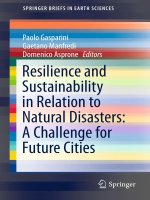(Mẫu powerpoint) caring for animals during natural disasters
Bạn đang xem bản rút gọn của tài liệu. Xem và tải ngay bản đầy đủ của tài liệu tại đây (4.94 MB, 15 trang )
Caring for Animals During
Natural Disasters
A guide for pet owners and rescue volunteers
In times of environmental events like
bushfires and volcanic eruptions, it's
important to keep the safety and welfare of
animals.
More often than not, in the face of fear and panic, owners and carers
unintentionally leave them behind.
PREPARE FOOD
AND WATER
Look for any food items left in your fridge that may be fed to your
pets or other animals left without shelter.
Look for any food items left in your fridge
WHAT TO DO WHEN YOUR FOOD
SUPPLIES ARE RUNNING LOW?
Contact your local animal shelter that may have food stored for times like these.
that may be fed to your pets or other
animals left without shelter.
COMFORT DISTRESSED
ANIMALS
They can feel disoriented and frightened by the chaos brought by
natural disasters. There are various ways to calm animals and
lessen their anxiety. You may try any of the following methods.
HOW TO COMFORT ANIMALS
Take away the stressor or remove them from the environment causing them
stress. If an animal is out on the streets looking distressed due to loud
thunder, keep them in a shelter with less noise.
Distract an animal from what's causing them anxiety. Apart from placing an animal in a calm
and quiet area, you may also give them a toy or some food to divert their attention.
HOW TO COMFORT ANIMALS
Note that they may feel disoriented too especially since disaster can greatly affect their
scent markers.
Take them to a veterinarian for proper medication when things have calmed down. It's
Talk to them in a soothing manner and stay closely by their side.
Handle them with care and gentleness especially when you can tell
they are feeling anxious and restless.
also important to check if animals caught any illnesses during the disaster so they can
be treated properly.
PLACE ANIMALS
IN A CLEAN ENVIRONMENT
Apart from reducing noise pollution, it's highly important to provide a clean space for the animal whether it's in your own home or an available location
outdoors.
Have trash bags and paper towels ready at all times to maintain the cleanliness of their
space.
PREPARE A CARRIER
Having a crate or carrier is extremely helpful during dire times when you need to take an animal with you.
OTHER ITEMS YOU MAY NEED
Make sure your pet is wearing a leash or collar with a tag
Bring your pet's medical records so veterinarians know how to
containing important information like its name, breed, and your
care for it in the best possible way when it gets injured or ill.
contact details.
Know how to bring your animals with you and where to go. Their evacuation is equally
important as yours. If it's not safe for you to stay behind, it's definitely not safe for them too.
PLAN YOUR
Note that animals may not be allowed to enter some evacuation centers except for service
animals. Hence, the importance of planning for their own logistics.
EVACUATION
Talk to your local animal organizations also for the best course of action. It is wise to know
what your community is up to in terms of mass evacuation of animals.
PREPARE
A FIRST AID KIT
Ask a veterinarian what items
you need to keep in this kit to better care for animals affected by natural
disasters. A kit may contain bandage rolls, ointment, and medicines.
DO YOUR RESEARCH AND FOLLOW INSTRUCTIONS
FROM CONCERNED AUTHORITIES
Seeking information on how to best care for different kinds of animals is a must. Listen to the advice of animal organizations and
provide assistance. This is especially important after a huge calamities like wildfires or hurricanes where several animals may be
displaced and are in need of care.
VOLUNTEER
During natural disasters, plenty of groups assemble to care for animals that have been affected. Help when you can and learn how to approach these
animals in the best possible way.









